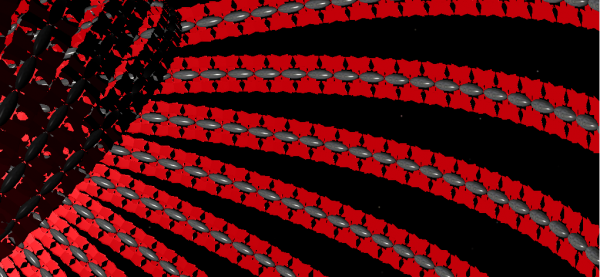BY LETTER
Tkzeph Empire
 Image from Steve Bowers | |
| According to some researchers, it was the Tkzeph who created the original dyson sphere that fell into ruin and was later reconstructed into the Black Acropolis. | |
Known only from a handful of ruins and dubious second-hand information obtained from contemporary xenosophonts, the Tkzeph (if these accounts are to be believed) appear to have been a vast and expansionist theocratic (or possibly aicratic) interstellar civilization which was active in the Milky Way around 312 million years ago. While the true extent of their empire remains a matter of speculation and debate, some of the aforementioned sources claim that at the height of their power the Tkzeph controlled a wormhole network far larger than the modern Terragen Nexus, possibly spanning as much as 38% of the galaxy. If true, this would make them the most expansive civilization known to have ever arisen in the Milky Way.
Accounts indicate that the Tkzeph Empire was a religious hegemony dedicated to worshipping a pantheon of "divines", generally believed by xenohistorians to have been a class of ruling transapient entities comparable to modern Terragen archailects. They evidently sought to convert all other sophont beings to their religion and bring them into their fold, by force if necessary; this would seem to account for the massive scope of their empire, as well as the seemingly widespread awareness of the Tkzeph among contemporary cultures, even those who had not encountered them directly.
While the circumstances surrounding this event are unclear, corresponding accounts originating from the Muuh and Silent Ones indicate that the Tkzeph Empire abruptly ceased to exist shortly after making contact with a far more primitive species, the Hov's'sa of Bentharis II, whom the Tkzeph attempted to subjugate and convert. According to these accounts, immediately after the Hov's'sa capitulated to the invaders, all communications from the Tkzeph fleet at Bentharis ceased, and shortly thereafter all activity across the entire Tkzeph Empire ground to a halt. To date, no independent evidence has been found to corroborate this narrative, and many xenohistorians have dismissed it as a muuh historific which made its way into the annals of other civilizations. Regardless, no evidence of Tkzeph activity has been found beyond the dates given in these records.
A disproportionate number of artifacts, probes, and ruined habitats that are about 310 to 320 million years old have been found in some systems that would have been relatively nearby each other at the time, close in age to the claimed flourishing of the Tkzeph; however, the effects of debris collisions and radiation have so damaged these that it is nearly impossible to tell anything about them other than that they are artificial. The actual extent of this civilization, and whether any of the accounts about the so-called "Tkzeph" bear any resemblance to the beings that left ruins, remains debated by xenoarchaeologists and other researchers. Some experts argue that all of these accounts are Muuh historifics, possibly inspired by these ruins, while others suggest they contain kernels of truth, handed down from earlier sources. Yet others argue that the accounts are largely accurate, and that most of the ruins of the Tkzeph have been destroyed by the legendary Restorers. Among this latter group are those who say that the Tkzeph are the creators of the original megastructure whose ruins were later reconstructed into the Black Acropolis.
Numerous artifacts purporting to be of Tkzeph origin have made their way into various marketplaces and auction houses throughout the Terragen Sphere, but the majority of these are considered to be of dubious provenance by xenoarchaeology experts. Likewise, no physical traces or representations have been found of the Tkzeph themselves, if they were indeed embodied sophonts at all. However, several historical data files shared by the Muuh and Silent Ones contain fragments of what is alleged to be recorded Tkzeph speech, suggesting that they may have utilized auditory communication in some capacity. Though severely degraded, the recordings are extensive enough for xenolinguists to have assembled an incomplete Tkzeph lexicon, consisting of around 150 "words"; one of these appears to be a signifier the Tkzeph used to refer to themselves, from which is derived their common phonetic name. From what little context can be gleaned from these partially-translated records, they appear to consist almost entirely of religious propaganda, in some cases intermixed with declarations of hostile intent toward contemporary civilizations.
Related Articles
Appears in Topics
Development Notes
Text by Andrew P. and ProxCenBound
expanded from the original article by Aaron Hamilton, with additional material by M. Alan Kazlev and Steve Bowers
Initially published on 31 July 2000.
Rewritten and expanded April 12, 2025.
expanded from the original article by Aaron Hamilton, with additional material by M. Alan Kazlev and Steve Bowers
Initially published on 31 July 2000.
Rewritten and expanded April 12, 2025.






